Rokna Reports
Stalled Talaghan Project: Tehran’s Thirst Driven by Mismanagement, Not Scarcity
Water has been stored in the Talaghan Dam, but its journey to Tehran remains blocked. At a time when other capital dams are critically low and summer temperatures are rising higher than ever, the Talaghan-to-Tehran water transfer project, despite the allocation of massive funds, has yet to be fully completed. Officials continue to call for water conservation without providing clear answers about the delays, inefficiencies, and failures in executing vital infrastructure. Tehran’s thirst stems more from erosion in decision-making and poor water management than from a shortage of resources.

According to Rokna’s social affairs correspondent, nestled in the Alborz Mountains, the Talaghan Dam stands with a capacity of 123 million cubic meters, marking it as one of Tehran’s key water sources. However, despite its high capacity, the water in Talaghan has no route to reach Tehran. A pipeline has been laid to deliver water to the capital, but its capacity is still insufficient to meet Tehran’s needs, and the project remains incomplete.
Currently, the combined volume of water in Latyan and Mamloo dams is only 30 million cubic meters, barely enough to meet peak seasonal demand. Amir Kabir (Karaj) Dam (39 million cubic meters) and the Lar Dam (57 million cubic meters) are also facing significant reductions, making them incapable of adequately supplying the capital.
In such circumstances, all eyes turned to Talaghan Dam. The project to transfer water from Talaghan, expected to alleviate Tehran’s water shortage over recent years, has not yet reached completion—despite the allocation of 50 trillion rials (5 “Hemat”). In Esfand 1403 (March 2025), Ministry of Energy officials announced the allocation of 5 Hemat for the water transfer project and set a deadline of Khordad 1404 (June 2025) for completion. However, with Tir 1404 (July 2025) now ending, the project has only reached 70% completion.
Officials had earlier promised that Talaghan’s water would reach Tehran by Khordad 1403 (June 2024), yet the project is still in the early phases of completion. While 70% of the infrastructure has been implemented, the full operational capacity is yet to be activated, and Talaghan’s water still plays no effective role in meeting the capital’s demand.
While water conservation is undoubtedly essential for reducing pressure on the city’s resources, the fundamental delays and backlogs in project execution must not be overlooked. There is no objection to promoting responsible drinking water use—indeed, such behavior should be seen as rational and necessary. But should officials cite household consumption as the only solution to the water crisis when critical infrastructure projects remain unfinished?
The question must be asked: why does a project that could have resolved part of Tehran’s water shortage still remain incomplete?
The Talaghan Dam water transfer project, envisioned as a vital solution to the capital’s water crisis, remains in limbo—awaiting final completion and activation. Under such conditions, citizens cannot be the only ones asked to bear the burden through reduced water use, while major infrastructure projects are left half-finished.
There is water in Talaghan, but no path to Tehran.
We wander parched—not from water scarcity, but from poor project execution.
There is water in Talaghan, yet we in Tehran remain thirsty.
Let this commentary serve not only as a reminder of a broken promise, but also as a serious call to reevaluate decisions and performance.
Water exists in Talaghan, but it has yet to flow meaningfully for all of us.
Public and private sector cooperation might be one of the most crucial solutions. Today, the need for collaboration between citizens and authorities, and leveraging private sector capabilities to navigate the water crisis, is clearly felt. Such cooperation can be effective not only in project execution, but also in changing consumption patterns and optimizing water resource management.
For this reason, there must be special attention to public education, awareness campaigns, and the cultivation of a culture of responsible water use.
Send Comments